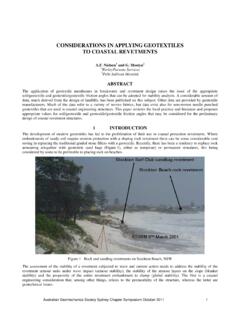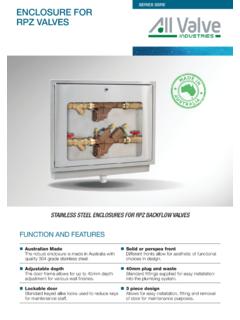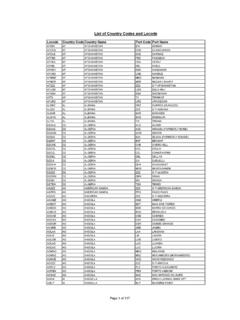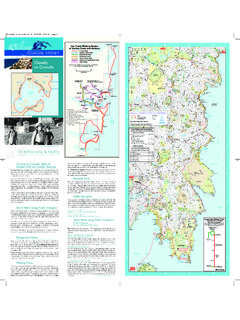Transcription of Sewage overflows management in the Sydney …
1 Sewage overflows management in the Sydney coastal region Literature Review December 2015 Sewage overflow management in Sydney Coastal Region i The primary aim of this project is to scope management options to reduce and mitigate the impacts of Sewage overflows in the Sydney coastal region, based on a review of international best practice and historical trends in Sewage management in Sydney . The topic was chosen as the 15 member councils of the Sydney Coastal Councils Group nominated Sewage overflows as their common issue of greatest concern. This review was prepared as a supporting document to the Issues Paper on Sewage overflows management in the Sydney coastal region. Alexandra Moors Independent Researcher On the Cover A picture of a pollution sign.
2 Image is the work of Rachael Smith. Source: Image is accessible at Sewage overflow management in Sydney Coastal Region ii TABLE OF CONTENTS 1. BACKGROUND / CONTEXT .. 1 Water management in Sydney .. 1 The natural water cycle .. 1 History of water management in Sydney .. 1 The urban water cycle .. 5 Interconnectedness .. 9 2. Sydney S URBAN SEWERAGE SYSTEM .. 11 Sydney Water sewerage system .. 11 Private sewerage system .. 15 Governance .. 15 Independent Pricing and Regulatory Tribunal .. 15 EPA .. 16 Sydney Water .. 16 3. overflows AND THEIR management .. 17 What is a Sewage overflow ? .. 17 Wet weather overflows .. 17 Dry weather overflows .. 18 Private overflows .. 18 Quantifying the issue: sites, impacts and risks .. 19 overflow locations.
3 19 Impacts of sewer overflows .. 23 Climate change risks .. 27 Current management strategies and practice .. 27 Current management framework .. 27 System capacity and performance .. 32 Sydney Water pricing and dividend .. 34 Proposed new licensing framework .. 35 Private sewer integrity Pipechecks .. 39 Community and Media Perspectives .. 40 Sewage overflow management in Sydney Coastal Region iii Community attitudes .. 40 Community preferred options .. 42 Willingness to pay (WTP).. 42 Media .. 43 4. INTERNATIONAL (BEST) PRACTICE / INDEPENDENT RESEARCH .. 45 Integrated Urban Water management .. 45 Water Sensitive Urban Design .. 47 International Best Practice .. 52 Sydney .. 55 Melbourne .. 57 Singapore .. 57 United States.
4 58 Germany .. 63 United Kingdom .. 64 Innovations yet to be implemented .. 64 Networked Infrastructure National Architecture System .. 64 First Flush Diversion .. 66 5. KEY ISSUES AND FUTURE management OPTIONS .. 67 Key Issues and Future management Options .. 67 6. POLITICAL ADVOCACY & POLICY POSITIONS .. 68 Sydney Water perspective .. 68 Member Councils perspective and projects .. 70 NSW Environment Protection Authority perspective .. 72 NGO perspective .. 73 7. CONCLUSION .. 75 REFERENCES .. 76 Appendix 1 Acronyms & Abbreviations .. 81 Appendix 2 Glossary .. 82 Appendix 3 Beachwatch Beach Suitability Grades 2009/10 2013/14 .. 86 Appendix 4 NSW Environment Protection Authority response to questions .. 89 Sewage overflow management in Sydney Coastal Region 1 1.
5 BACKGROUND / CONTEXT Water management in Sydney is best understood in the context of the natural water cycle, the history of water governance in Sydney , the urban water cycle and the interconnectedness of water systems. Section 1 will examine each of these elements. Water management in Sydney The natural water cycle Water constantly moves through a natural cycle of evaporation, condensation, precipitation and infiltration through which it is cleaned and recycled. This cycle is called the natural water cycle and is illustrated in Figure 1. Figure 1: The Natural Water Cycle ( Sydney Water Corporation, 2015f) As cities develop, the water cycle becomes modified to create an urban water cycle. Today s urban water cycle is a function of the history of water management in Sydney .
6 This history will now be explored. History of water management in Sydney The development of any complex system which has taken place over a long time period and has been contributed to by many different people is always a combination of what in hindsight turns out to be some poor decisions made for short term expediency and some better decisions made by long term planning. What is possible for the future is very largely determined by what has gone before (Henry, 1939). This is certainly true of the water supply and sewerage systems of Sydney . The systems we have today are a legacy of their past history of management , and similarly what will be possible for the future will be a product of the decisions we make today. Sewage overflow management in Sydney Coastal Region 2 History of Sydney s Water Supply management Sydney has unreliable rainfall, so supplying adequate water for the growing population has been a constant challenge since white settlement in 1788.
7 Water in fact determined the site of Sydney . Governor Phillip knew the new settlement would need to be located near a source of fresh water. So between 18th and 20th of January 1788 he set out to find such a site, and discovered a clear running stream in Sydney Cove. This stream became known as the Tank Stream after three tanks that had been excavated near its channel. The settlement grew on either side of this stream. However within 28 years the population of Sydney had grown to 10,000 and the stream had become so polluted by waste from households and industry, that it resembled an open sewer. No longer suitable as a water source and to reduce the risk of disease, the stream was eventually covered in with a tunnel and became the main sewer line for Sydney . Between 1826 and 1830 the town relied on wells and rainwater, but a new water source was needed.
8 From 1830 to 1858 Sydney s second source of water supply was Busby s Bore, in the Lachlan Swamps (now Centennial Park). The population had reached about 20,000 and convict labour was used to build a tunnel from the Lachlan Swamps to Hyde Park, where water carts then delivered water to various parts of the city. This was Sydney s first water reticulation system. By 1849 the city s population had grown to 40,000, then by 1852 to 50,000, due to the gold rush. An additional water supply source was again needed and in 1858 the Botany Swamps Water Supply Scheme was introduced. Pumping stations were built to pump water from the Botany Swamps to reservoirs at Crown Street, Paddington, Woollahra and Waverley Park. Dams were also constructed along the course of the Botany Swamps to provide water during drought and to meet the needs of the growing city.
9 In 1886 a reservoir built at Prospect took over the supply of water to Sydney , which had a population by this time of 296,000. To meet predicted water demand, the Upper Nepean Scheme was then introduced to tap the waters of the Nepean River and its tributaries. Four storage dams were constructed: the Cataract storage dam completed in 1911, the Cordeaux and Avon Dams completed in 1926 and the Nepean Dam completed in 1933. These four dams completely controlled the run off from three quarters of the Nepean catchment area, with the balance controlled by weirs. A 1924 Act gave the Metropolitan Water Sewerage and Drainage Board ( Sydney Water s predecessor) control over the catchment area and the ability to prevent actions likely to contaminate the water. By 1939 Sydney s population had grown to million and to meet its needs and cope with drought, the Woronora Dam was completed in 1941.
10 In 1948 construction of one of the world s largest reservoirs of water, the Warragamba Dam began. It was completed in 1960 (Aird, 1961) and today remains Sydney s largest water source. Sewage overflow management in Sydney Coastal Region 3 In 1996 the privately built, owned and operated (BOO) Prospect Water Filtration Plant was completed (today 90 percent of Sydney s water is treated and filtered in privately owned filtration plants). In 2001-2002 the Rouse Hill Recycled Water Scheme delivered recycled water to local residents using dual reticulation (separate pipes to drinking water pipes). This is the southern hemisphere s largest residential dual reticulation system. Low rainfall between 1998 and 2007 caused Warragamba Dam to reach an all time low of percent of capacity ( Sydney Catchment Authority, 2007).








